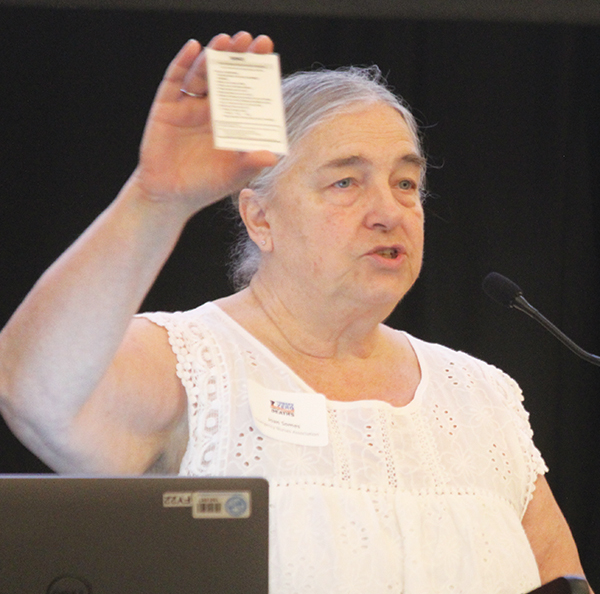‘Life-changing crashes’ a concern at workshop
Safety data presented at ‘Toward Zero Deaths program

Photo by Deb Gau Presenter Joan Somes speaks about risks facing older drivers at a Toward Zero Deaths regional workshop on Thursday.
GRANITE FALLS — The past three years have shown some concerning trends for traffic crashes in southwest Minnesota. The number of fatalities and serious injuries in 2020 through 2022 is up 24% compared to 2017-19, Ken E. Johnson said.
Johnson, assistant state traffic engineer with the MnDOT office of traffic engineering, shared state crash data during a regional Toward Zero Deaths (TZD) workshop on Thursday. The workshop brought together traffic safety stakeholders including law enforcement officers, health and safety educators, and emergency medical responders.
Johnson said traffic fatalities and injuries have been on the rise in the region, as have crashes involving impaired drivers or people not wearing seatbelts. At the same time, crash data also included some positive changes in some counties.
“On the plus side, there are actually three counties that had zero fatalities: Chippewa, Lac qui Parle, and Redwood. And we had about 12 counties statewide that had zero fatalities in 2022,” Johnson said.
State crash data for 2022 showed an increase in traffic fatalities, both statewide and in southwest Minnesota, Johnson said. In 2021, there were 488 fatalities statewide. Preliminary crash data showed there were 446 fatalities in 2022. In southwest Minnesota, the data showed there were 22 fatalities in 2021, and 28 fatalities in 2022.
“A lot of it could be pandemic-related. There was a lot of higher-speed traffic out there, there were people that were starting to not use their seatbelts, quite a few things,” Johnson said.
Some of the data showed areas of possible concern in preventing life-changing crashes in the region, Johnson said.
“We’re concerned about life-changing crashes that result in people losing their lives or people having serious injuries that impact them for the rest of their life,” he said.
In one example, the number of fatal and serious injury crashes happening on county and city roads increased faster than expected over the past three years. From 2017 to 2019, there were an average of 35 fatal and serious injury crashes a year on county roads. But in 2020-22, the average was 45 fatal and serious injury crashes a year.
For city streets, fatal and serious injury crashes went from an average of nine per year in 2017-19, to 13 per year in 2020-22.
Johnson said fatal and serious injury crashes related to driver behavior showed some areas of concern for southwest Minnesota.
“These are areas that we’ll definitely want to really pay attention to within this region,” he said.
Those factors included speeding, driving while impaired, and not wearing seatbelts.
“Impairment has had a very steep rise since 2019. Speed has increased as well. Unbelted occupants, that has increased since 2020,” he said.
Fatal and serious injury crashes involving unlicensed drivers had increased from 2020, as had crashes involving older drivers, Johnson said.
There was also “a large increase” in the number of single-vehicle, run-off-the-road crashes, he said.
Another presenter at the workshop, Joan Somes of the Emergency Nurses Association, gave some additional perspective on the risks of crashes involving older drivers. Nationwide, drivers age 55 and older accounted for about 27% of motorcycle deaths in 2020. That was a 37% increase from 2011, Somes said.
As we age, we go through changes in everything from our physical strength and flexibility, to balance, vision, hearing and reaction time, Somes said. All of those factors can affect a person’s ability to drive safely. Other physical changes of aging can make crash injuries more severe for older adults, and lead to worse outcomes.
“The fatality risk, if you are over 85 years old, is 96% if you’re in an unprotected crash,” Somes said.
Crashes involving motorcycles, bicycles, golf carts or ATVs are all dangerous for older adults, because drivers are less protected on those vehicles, Somes said.
Promoting safety can help prevent injuries and deaths among older drivers, she said. She said drivers should be encouraged not to ride a motorcycle that’s too large for them, to wear helmets and protective gear, and to attend safety classes.



